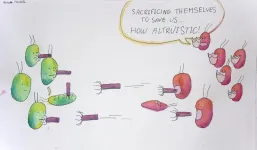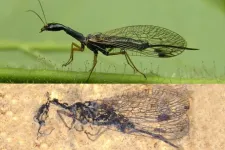(Press-News.org) Imagine there are arrows that are lethal when fired on your enemies yet harmless if they fall on your friends. It's easy to see how these would be an amazing advantage in warfare, if they were real. However, something just like these arrows does indeed exist, and they are used in warfare ... just on a different scale.
These weapons are called tailocins, and the reality is almost stranger than fiction.
"Tailocins are extremely strong protein nanomachines made by bacteria," explained Vivek Mutalik, a research scientist at Lawrence Berkeley National Laboratory (Berkeley Lab) who studies tailocins and phages, the bacteria-infecting viruses that tailocins appear to be remnants of. "They look like phages but they don't have the capsid, which is the 'head' of the phage that contains the viral DNA and replication machinery. So, they're like a spring-powered needle that goes and sits on the target cell, then appears to poke all the way through the cell membrane making a hole to the cytoplasm, so the cell loses its ions and contents and collapses."
A wide variety of bacteria are capable of producing tailocins, and seem to do so under stress conditions. Because the tailocins are only lethal to specific strains - so specific, in fact, that they have earned the nickname "bacterial homing missiles" - tailocins appear to be a tool used by bacteria to compete with their rivals. Due to their similarity with phages, scientists believe that the tailocins are produced by DNA that was originally inserted into bacterial genomes during viral infections (viruses give their hosts instructions to make more of themselves), and over evolutionary time, the bacteria discarded the parts of the phage DNA that weren't beneficial but kept the parts that could be co-opted for their own benefit.
But, unlike most abilities that are selected through evolution, tailocins do not save the individual. According to Mutalik, bacteria are killed if they produce tailocins, just as they would be if they were infected by true phage virus, because the pointed nanomachines erupt through the membrane to exit the producing cell much like replicated viral particles. But once released, the tailocins only target certain strains, sparing the other cells of the host lineage.
"They benefit kin but the individual is sacrificed, which is a type of altruistic behavior. But we don't yet understand how this phenomenon happens in nature," said Mutalik. Scientists also don't know precisely how the stabbing needle plunger of the tailocin functions.
These topics, and tailocins as a whole, are an area of hot research due to the many possible applications. Mutalik and his colleagues in Berkeley Lab's Biosciences Area along with collaborators at UC Berkeley are interested in harnessing tailocins to better study microbiomes. Other groups are keen to use tailocins as an alternative to traditional antibiotics -which indiscriminately wipe out beneficial strains alongside the bad and are increasingly ineffective due to the evolution of drug-resistance traits.
In their most recent paper, the collaborative Berkeley team explored the genetic basis and physical mechanisms governing how tailocins attack specific strains, and looked at genetic similarities and differences between tailocin producers and their target strains.
After examining 12 strains of soil bacteria known to use tailocins, the biologists found evidence that differences in the lipopolysaccharides - fat- and sugar-based molecules - attached to the outer membranes could determine whether or not a strain is targeted by a particular tailocin.
"The bacteria we studied live in a challenging, resource-poor environment, so we're interested to see how they might be using tailocins to fight for survival," said Adam Arkin, co-lead author and a senior faculty scientist in the Biosciences Area and technical co-manager of the Ecosystems and Networks Integrated with Genes and Molecular Assemblies (ENIGMA) Scientific Focus Area. Arkin noted that although scientists can easily induce bacteria to produce tailocins in the lab (and can easily insert the genes into culturable strains for mass production, which will be handy if we want to make tailocins into medicines) there are still a lot of unanswered questions about how bacteria deploy tailocins in their natural environment, as well as how - and why - particular strains are targeted with an assassin's precision.
"Once we understand the targeting mechanisms, we can start using these tailocins ourselves," Arkin added. "The potential for medicine is obviously huge, but it would also be incredible for the kind of science we do, which is studying how environmental microbes interact and the roles of these interactions in important ecological processes, like carbon sequestration and nitrogen processing."
Currently, it's very difficult to figure out what each microbe in a community is doing, as scientists can't easily add and subtract strains and observe the outcome. With properly harnessed tailocins, these experiments could be done easily.
Mutalik, Arkin, and their colleagues are also conducting follow-up studies aiming to reveal tailocins' mechanisms of action. They plan to use the advanced imaging facilities at Berkeley Lab to take atomic-level snapshots of the entire process, from the moment the tailocin binds to the target cell all the way to cell deflation. Essentially, they'll be filming frames of a microscopic slasher movie.
INFORMATION:
This work is part of the ENIGMA Scientific Focus Area, a multi-institutional consortium led by Berkeley Lab focused on advancing our understanding of microbial biology and the impact of microbial communities on their ecosystems. ENIGMA is supported by the Department of Energy's Office of Science.
Founded in 1931 on the belief that the biggest scientific challenges are best addressed by teams, Lawrence Berkeley National Laboratory and its scientists have been recognized with 14 Nobel Prizes. Today, Berkeley Lab researchers develop sustainable energy and environmental solutions, create useful new materials, advance the frontiers of computing, and probe the mysteries of life, matter, and the universe. Scientists from around the world rely on the Lab's facilities for their own discovery science. Berkeley Lab is a multiprogram national laboratory, managed by the University of California for the U.S. Department of Energy's Office of Science.
DOE's Office of Science is the single largest supporter of basic research in the physical sciences in the United States, and is working to address some of the most pressing challenges of our time. For more information, please visit energy.gov/science.
AI-powered symptom checkers can potentially reduce the number of people going to in-person clinics during the pandemic, but first, researchers say, people need to know they exist.
COVID symptom checkers are digital self-assessment tools that use AI to help users identify their level of COVID-19 risk and assess whether they need to seek urgent care based on their reported symptoms. These tools also aim to provide reassurance to people who are experiencing symptoms that are not COVID-19 related.
Most platforms, like Babylon and Isabel, are public-facing tools, but the University of California, San Francisco (UCSF) has one of the first COVID-19 symptom checkers that is fully integrated with the users' medical ...
Study using electronic health records of 236,379 COVID-19 patients mostly from the USA estimates that one in three COVID-19 survivors (34%) were diagnosed with a neurological or psychiatric condition within six months of infection.
Anxiety (17%) and mood disorders (14%) were the most common. Neurological diagnoses such as stroke and dementia were rarer, but not uncommon in those who had been seriously ill during COVID-19 infection. For example, of those who had been admitted to intensive care, 7% had a stroke and almost 2% were diagnosed with dementia.
These diagnoses were more common in COVID-19 patients than in flu or respiratory tract infection patients ...
Highlight
Most patients with kidney failure who were undergoing hemodialysis developed a positive antibody response after being vaccinated for COVID-19, but their response was lower than that of individuals without kidney disease.
Washington, DC (April 6, 2021) -- In a recent study, most patients with kidney failure who were undergoing hemodialysis developed a substantial antibody response following the vaccination with the Pfizer-BioNTech vaccine against COVID-19, but it was significantly lower than that of individuals without kidney disease. The findings will appear in an upcoming ...
CHAPEL HILL, NC - A team led by scientists at the UNC School of Medicine identified a molecule called microRNA-29 as a powerful controller of brain maturation in mammals. Deleting microRNA-29 in mice caused problems very similar to those seen in autism, epilepsy, and other neurodevelopmental conditions.
The results, published in Cell Reports, illuminate an important process in the normal maturation of the brain and point to the possibility that disrupting this process could contribute to multiple human brain diseases.
"We think abnormalities in microRNA-29 activity are likely to be a common theme in neurodevelopmental ...
Chestnut Hill, Mass. (4/6/2021) -- Compact logos can encourage favorable brand evaluations by signaling product safety, according to a new study by researchers at Boston College's Carroll School of Management and Indian Institute of Management Udaipur, who reviewed the opinions of 17,000 consumers and conducted additional experiments with a variety of logos.
The findings reveal that typography -- specifically tracking, or the spacing between letters in a word -- can influence consumers' interpretations of brand logos. Further, the interpretation is influenced by cultural factors, the researchers reported ...
Fossil discoveries often help answer long-standing questions about how our modern world came to be. However, sometimes they only deepen the mystery--as a recent discovery of four new species of ancient insects in British Columbia and Washington state is proving.
The fossil species, recently discovered by paleontologists Bruce Archibald of Simon Fraser University and Vladimir Makarkin of the Russian Academy of Sciences, are from a group of insects known as snakeflies, now shown to have lived in the region some 50 million years ago. The findings, published in Zootaxa, raise more questions about the evolutionary history of the distinctly elongated insects and why they live where they do today.
Snakeflies are slender, predatory insects that are native to the Northern Hemisphere ...
Starting your day by thinking about what kind of leader you want to be can make you more effective at work, a new study finds.
"It's as simple as taking a few moments in the morning while you're drinking your coffee to reflect on who you want to be as a leader," said Remy Jennings, a doctoral student in the University of Florida's Warrington College of Business, who authored the study in the journal Personnel Psychology with UF management professor Klodiana Lanaj.
When study participants took that step, they were more likely to report helping co-workers and providing ...
April 6, 2021, Alexandria, VA - The American Academy of Otolaryngology?Head and Neck Surgery Foundation published the Clinical Practice Guideline: Opioid Prescribing for Analgesia After Common Otolaryngology Operations today in Otolaryngology-Head and Neck Surgery. This specialty-specific guideline provides evidence-based recommendations on postoperative management for pain in common otolaryngologic procedures, with a focus on opioids.
"As otolaryngologist-head and neck surgeons, we can help reduce the risk of opioid use disorder among our patients and their families," said Samantha Anne, MD, MS, Chair of the Guideline Development Group (GDG). "This clinical practice guideline ...
A new large-scale study led by UC Davis Health and UC San Francisco researchers assessed the risks of leukemia in children with Down syndrome. It pointed to stronger than expected associations between Down syndrome and acute myeloid leukemia (AML), one type of blood cancer.
Down syndrome is one of the most common genetic conditions in the U.S. and Canada. According to the U.S. Centers for Disease Control and Prevention, about 6,000 babies with Down syndrome are born in the United States each year. That's approximately one in every 700 babies born in the U.S. and one in 750 newborns ...
Tweets about Russia by Donald Trump during his presidency caused short but noticeable depreciations of the rouble. Meanwhile, the introduction of new sanctions, upon which the president did not comment, had no such effect. This was the finding of a group of researchers, which included Elena Fedorova, Professor of the Faculty of Economic Sciences of HSE University. The group published their findings in in the Journal of Economic Behavior and Organization.
With the growing influence of social media, officials, politicians, and entrepreneurs increasingly express their positions on various issues directly (for example, using Facebook or Twitter), and their messages serve as an independent source of financial and business ...



